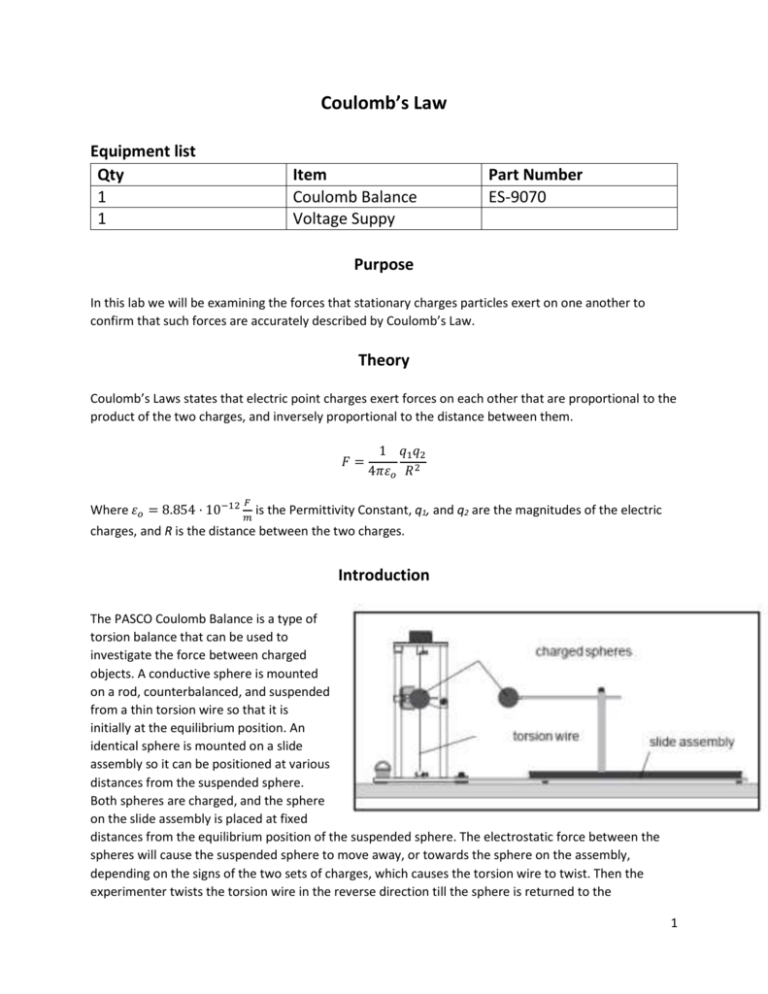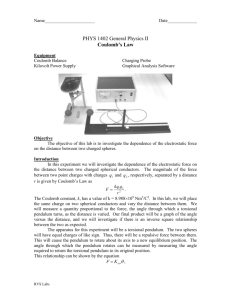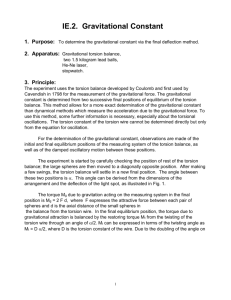Coulomb`s Law
advertisement

Coulomb’s Law Equipment list Qty 1 1 Item Coulomb Balance Voltage Suppy Part Number ES-9070 Purpose In this lab we will be examining the forces that stationary charges particles exert on one another to confirm that such forces are accurately described by Coulomb’s Law. Theory Coulomb’s Laws states that electric point charges exert forces on each other that are proportional to the product of the two charges, and inversely proportional to the distance between them. 𝐹= 1 𝑞1 𝑞2 4𝜋𝜀𝑜 𝑅 2 𝐹 Where 𝜀𝑜 = 8.854 · 10−12 𝑚 is the Permittivity Constant, q1, and q2 are the magnitudes of the electric charges, and R is the distance between the two charges. Introduction The PASCO Coulomb Balance is a type of torsion balance that can be used to investigate the force between charged objects. A conductive sphere is mounted on a rod, counterbalanced, and suspended from a thin torsion wire so that it is initially at the equilibrium position. An identical sphere is mounted on a slide assembly so it can be positioned at various distances from the suspended sphere. Both spheres are charged, and the sphere on the slide assembly is placed at fixed distances from the equilibrium position of the suspended sphere. The electrostatic force between the spheres will cause the suspended sphere to move away, or towards the sphere on the assembly, depending on the signs of the two sets of charges, which causes the torsion wire to twist. Then the experimenter twists the torsion wire in the reverse direction till the sphere is returned to the 1 equilibrium position. The angle, Δθ that the torsion wire must be twisted through to return the sphere to the equilibrium position is directly proportional to the electrostatic force between the two spheres. Coulomb’s law tells us the magnitude of the electrostatic force between two point charges fixed in location relative to each other. However, in this experiment we will NOT be dealing with point charges, but spherical charge distributions instead. Now if all those little charge carriers (electrons) on our shells were fixed in location on those spherical shells that wouldn’t be a problem because uniform spherical charge distributions behave in many ways as if they were point charges with all the charge located at the center of the sphere. However, the charges on your spherical shells are NOT fixed in locations, but will redistribute themselves on those shells as the distance between the two shells changes. It turns out that the charges will redistribute themselves in a manner that minimizes the electrostatic energy of the system. The system being the total net charge on the two shells. Thankfully, we can mathematically correct for the charges redistributing themselves with a unit less correction factor B. Which is given by the following equation. 𝐵 =1−4 𝑟3 𝑅3 Here r is the radius of the spheres themselves, and R is the current distance that separates the centers of the two spheres. We will divide our angles Δθ by B to correct for the redistribution of charge. Which will give us the corrected angle Δθc. 𝛥𝜗𝑐 = ∆𝜗𝑎𝑣𝑔 𝐵 A torsion balance utilizes Hook’s Law to measure the force being exerted on it. As you should recall from first semester physics Hook’s Law is 𝐹 = 𝑘∆𝑥 Where Δx is the amount the system has been displaced from its equilibrium position, k is the Force Constant of the system, F is the applied force. What you may, or may not have learned in the first semester physics is that there is also a rotational version of Hook’s Law, and that version is 𝜏 = 𝛫𝛥𝜗 Here Δϑ is the angular displacement of the system from equilibrium, Κ (Kappa) is the torque constant of the system, τ is the applied torque. Also, torque is related to the applied force by the following equation. 𝜏 = 𝐹⊥ 𝐿 2 Where L is the level arm, and F⊥ is the force component perpendicular to the level arm. So if we set these two equations for torque equal to each other we get the following equation. 𝐹⊥ 𝐿 = 𝛫𝛥𝜗 Then solving for F⊥ gives 𝐹⊥ = 𝛫 𝛥𝜗 𝐿 From this we can clearly see that the perpendicular component of the force is proportional to the angular displacement experienced by the system. We will arrange our system such that the force vector is applied to the torsion balance perpendicularly resulting in 𝐹= 𝛫 𝛥𝜗 𝐿 Since the force being applied to our system is the electrostatic force described by Coulomb’s Law this means that the electrostatic force the two spherical charges exert on each other will be proportional to our corrected measured angular displacement Δϑc. It also means that the corrected angle will be proportional to the inverse of the square of the distance between the centers of the two spheres, and you can clearly see that when we set the two force equations equal to each other. 𝛫 1 𝑞1 𝑞2 𝛥𝜗𝑐 = 𝐿 4𝜋𝜀𝑜 𝑅 2 Apply a little algebra, and here it is. 𝛥𝜗𝑐 = 𝐿𝑞1 𝑞2 1 4𝜋𝜀𝑜 𝛫 𝑅 2 3 Setup Part 1: Torsion Balance 1. Attach one of the conductive spheres to the fiber glass rod of the pendulum assembly. 2. Slide the copper rings onto the counterweight vane, as shown in the bottom of figure 3. Then release the packing clamp that holds the counterweight vane, as shown in the top of figure 3. Adjust the position of the copper rings so the pendulum assembly is level. 3. Reposition the index are so it is parallel with the base of the torsion balance and at the same height as the vane. 4. Adjust the height of the magnetic damping arm so the counterweight vane is midway between the magnets. 5. Turn the torsion knob until the index line for the degree scale is aligned with the zero degree mark. 6. Rotate the bottom torsion wire retainer (do NOT loosen or tighten the thumbscrew) until the index line on the counterweight vane aligns with the index line on the index arm. 7. Carefully turn the torsion balance on its side, supporting it with the lateral support bar, as shown in figure 4. Place the support tube under the sphere, as shown. 8. Adjust the positions of the copper rings on the counterweight vane to realign the index line on the counterweight with the index line on the index arm. 9. Place the torsion balance up right. Setup Part 2: Slide Assembly 4 1. Connect the slide assembly to the torsion balance as shown in figure 5, using the coupling plate and thumbscrews to secure it in position. 2. Align the spheres vertically by adjusting the height of the pendulum assembly so the spheres are aligned: Use the supplied Allen wrench to loosen the screw that anchors the pendulum assembly to the torsion wire. Adjust the height of the pendulum assembly as needed. Readjust the height of the index arm and the magnetic damping arm as needed to reestablish a horizontal relationship. 3. Align the spheres laterally by loosening the screw in the bottom of the slide assembly that anchors the vertical support rod for the sphere, using the supplied Allen wrench (the vertical support rod must be moved to the end of the slide assembly, touching the white plastic knob to access the screw). Move the sphere on the vertical rod until it is laterally aligned with the suspended sphere and tighten the anchoring screw. 4. Position the slide arm so that the centimeter scale reads 3.8 cm. This distance is equal to the diameter of the spheres. 5. Position the spheres by loosening the thumbscrew on top of the rod that supports the sliding sphere and sliding the horizontal support rod through the hole in the vertical support rod until the two spheres just touch. Tighten the thumbscrew. At this point the degree scale should read zero, the torsion balance should be zeroed (the index lines should be aligned), the spheres should be just touching, and the centimeter scale on the slide assembly should read 3.8 cm, which is the current distance between the center of the spheres. If all of that is true then you have set up the equipment correct, and you are ready to begin the experiment. Tips for Accurate Results 1. Perform the experiment in a draft-free room. (Close the lab room door to decrease air circulation. A slight draft on the Torsion Balance will cause it to twist one way or the other, there by affect the reading.) 2. Position the Coulomb Balance a couple feet away from walls or other surfaces that easily induced to hold a charge. 5 3. When performing the experiment stand directly behind the balance and at a maximum comfortable distance from it. (This is to help deter any static charge that might have built up on yourself, or your clothing from interfering with the experiment.) 4. If it is possible attach a grounding wire to the experimenters themselves. 5. When charging the spheres turn the voltage source just a moment or so before charging the spheres, then turn the voltage source off right after charging the spheres. (This will help prevent ‘voltage leak’ which could affect the results of the experiment.) 6. When charging the spheres hold the charging probe near the end of the handle, so your hand is as far from the sphere as possible. (This is to help deter static build up on the experimenter being transferred to the spheres.) 7. Surface contamination on the rods that support the charge spheres can cause charge leakage. To prevent this, avoid handling these parts as much as possible and occasionally wipe them with alcohol to remove contamination. 8. There will always be some charge leakage. Perform the measurements as quickly as possible after charging to minimize the leakage effects. 9. Recharge the spheres before each measurement. Procedure 1. After setting up the Coulomb Balance as described above make sure the spheres are fully discharged (touch them with a grounded probe) and move the sliding sphere as far as possible from the suspended sphere. Set the torsion dial to 0. Zero the torsion balance by appropriately rotating the bottom torsion wire retainer until the pendulum assembly is at zero displacement position as indicated by the index marks. 2. With the spheres still at maximum separation, charge both spheres to a potential of somewhere between 6 – 7 kV, using the charging probe. (One terminal of the power supply should be grounded.) Immediately after charging the spheres, turn the power supply off to avoid high voltage leakage effects. 3. Position the sliding sphere at a position of 20 cm. Adjust the torsion knob as necessary to balance the forces and bring the pendulum back to the zero position. Record the distance R and the angle Δθ in Table 1. 4. Separate the spheres to their maximum separation, recharge them to the same voltage, then reposition the sliding sphere at a separation of 20 cm. Measure the torsion angle and record your result again. Keep repeating doing this till your torsion angle is repeatable to ±1𝑜 . Record ALL of your measurements. 5. Repeat this procedure for separation distances of 14, 10, 9, 8, 7, 6, and 5 centimeters. 6 7 Analysis Table 1 R(m) 𝟏 𝑹𝟐 𝜟𝜽 𝜟𝜽𝒂𝒗𝒈 B 𝜟𝜽𝒄 R(m) 0.20 0.08 0.14 0.07 0.10 0.06 0.09 0.05 𝟏 𝑹𝟐 𝜟𝜽 𝜟𝜽𝒂𝒗𝒈 B 𝜟𝜽𝒄 8 1. Complete Table 1, by finding the average value of the angle Δθavg for each distance. Then calculate the correction factor B for each distance, and finally calculate the corrected angle Δθc for each distance. Show work in the space provided. 2. Using Excel, or some other graphing program plot B vs. R, and find the treadline that best fits the graph. 3. Normally an electric charge will distribute itself uniformly over a smooth surface such as a sphere. However the presence of another collection of charges a distance R away from that sphere of charge affects how it is distributed itself over that surface. What does your B vs. R graph tell you about how R affects the uniformity of that distribution? 1 4. Using Excel, or some other graphing program plot of 𝜗𝑐 𝑣𝑠. 𝑅2, and find the Treadline. 5. Does this graph show that the electrostatic force between the two charges is proportional to the inverse of R2. Justify your answer. 6. Calculate log(𝛥𝜗𝑐 ), log(𝑅), and enter the values in Table 2. Show work in space provided. Table 2 log(Δθc) log(R) 9 7. Plot log(𝛥𝜗𝑐 ) 𝑣𝑠. log(𝑅) 10







